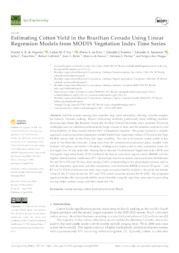Estimating Cotton Yield in the Brazilian Cerrado Using Linear Regression Models from MODIS Vegetation Index Time Series.
Estimating Cotton Yield in the Brazilian Cerrado Using Linear Regression Models from MODIS Vegetation Index Time Series.
Resumo: Abstract: Satellite remote sensing data expedite crop yield estimation, offering valuable insights for farmers’ decision making. Recent forecasting methods, particularly those utilizing machine learning algorithms like Random Forest and Artificial Neural Networks, show promise. However, challenges such as validation performances, large volume of data, and the inherent complexity and inexplicability of these models hinder their widespread adoption. This paper presents a simpler approach, employing linear regression models fitted from vegetation indices (VIs) extracted from MODIS sensor data on the Terra and Aqua satellites. The aim is to forecast cotton yields in key areas of the Brazilian Cerrado. Using data from 281 commercial production plots, models were trained (167 plots) and tested (114 plots), relating seed cotton yield to nine commonly used VIs averaged over 15-day intervals. Among the evaluated VIs, Enhanced Vegetation Index (EVI) and Triangular Vegetation Index (TVI) exhibited the lowest root mean square errors (RMSE) and the highest etermination coefficients (R2 ). Optimal periods for in-season yield prediction fell between 90 and 105 to 135 and 150 days after sowing (DAS), corresponding to key phenological phases such as boll development, open boll, and fiber maturation, with the lowest RMSE of about 750 kg ha?1 and R 2 of 0.70. The best forecasts for early crop stages were provided by models at the peaks (maximum value of the VI time series) for EVI and TVI, which occurred around 80–90 DAS. The proposed approach makes the yield predictability more inferable along the crop time series just by providing sowing dates, contour maps, and their respective VIs.
Ano de publicação: 2024
Tipo de publicação: Artigo de periódico
Unidade: Embrapa Instrumentação
Observações
1 - Por padrão são exibidas publicações dos últimos 20 anos. Para encontrar publicações mais antigas, configure o filtro ano de publicação, colocando o ano a partir do qual você deseja encontrar publicações. O filtro está na coluna da esquerda na busca acima.
2 - Para ler algumas publicações da Embrapa (apenas as que estão em formato ePub), é necessário ter, no celular ou computador, um desses softwares gratuitos. Sistemas Android: Google Play Livros; IOS: iBooks; Windows e Linux: software Calibre.
Acesse outras publicações
Acesse a Base de Dados da Pesquisa Agropecuária (BDPA) para consultar o acervo completo das bibliotecas da Embrapa.

